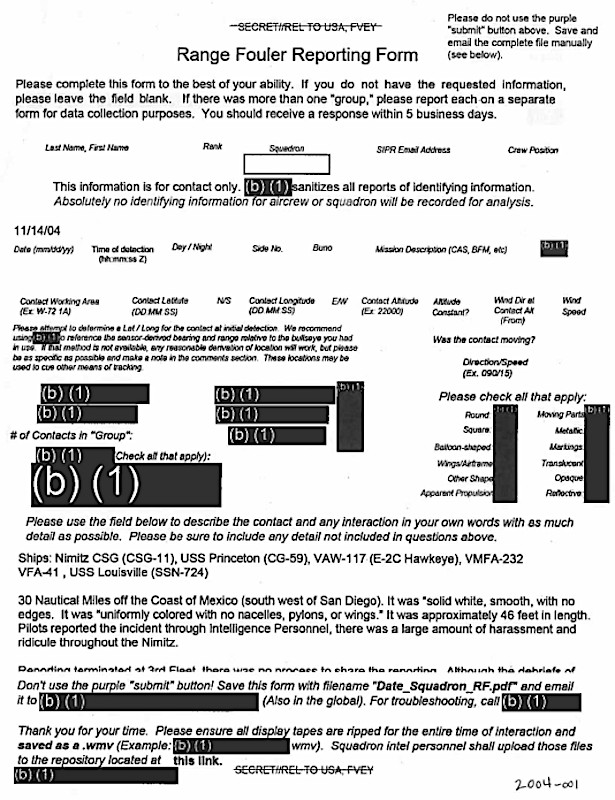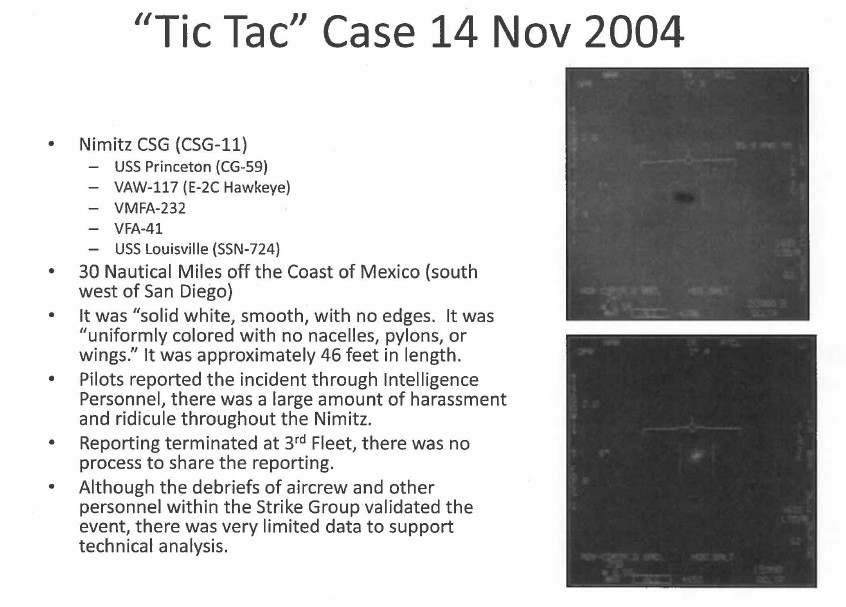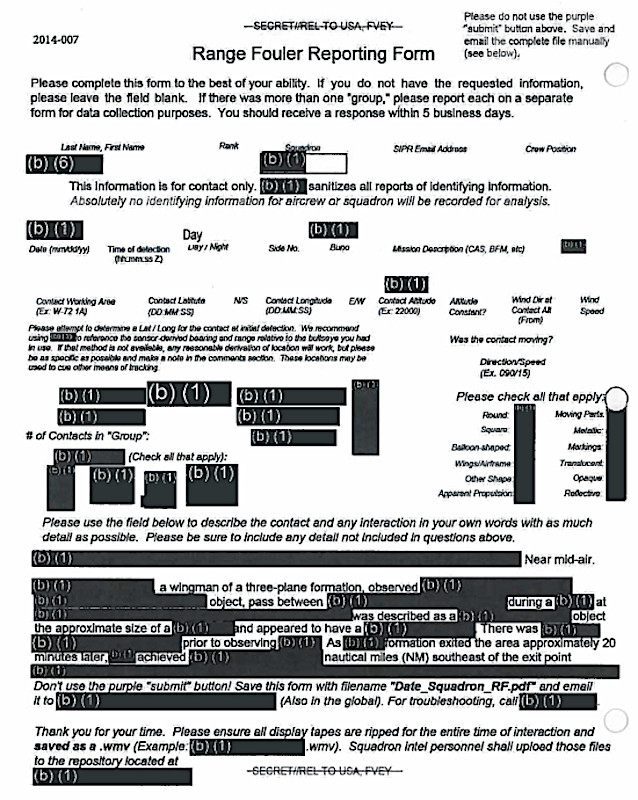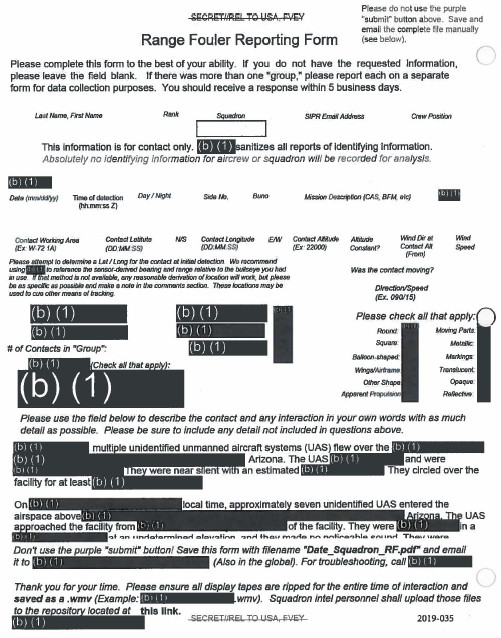The U.S. Navy has released 72 heavily redacted reports regarding unidentified aircraft and other objects that its pilots encountered during various training sorties and other flight activities between 2004 and 2021. This includes a report on what is now a very well-known, compelling, and so far unexplained incident off the coast of Mexico in 2004 involving an unidentified object commonly referred to as the “Tic Tac” due to its general shape and color, which you can read more about in this past War Zone feature.
The New York Post‘s Steven Greenstreet was among the first to notice that the documents appeared to have been posted yesterday in the Navy’s online Freedom of Information Act (FOIA) reading room, along with a copy of a briefing slide related to the “Tic Tac” incident, all inside a folder labeled “UAP INFO.” UAP refers to unidentified aerial phenomena, a term the U.S. military and others now use to describe what have historically been called unidentified flying objects (UFO). The Office of the Director of National Intelligence (ODNI) also notably released an annual unclassified report regarding UAPs during the 2022 calendar year yesterday, which was highly anticipated, but thin on details, as we have already reported on.
All 72 of the reports have to do with incidents that were categorized as involving “range foulers,” which the Navy defines “as an activity or object that interrupts pre-planned training or other military activity in a military operating area or restricted airspace.” The redacted documents show that they were all originally classified as Secret and were marked with further special instructions to only release them to approved U.S. nationals and those from the other four countries that make up the Five Eyes (FVEY) intelligence bloc (Australia, Canada, the United Kingdom, and New Zealand).

If it is important to note that this batch of records does not cover all range fouler incidents recorded between 2004 and 2021. There are no reports included here at all from 2005 to 2007, 2009 to 2012, 2017, or 2020. The Navy has previously released other UAP-related range fouler reports, including a number of them that were recorded during 2020.
Without knowing what specific parameters may have been used to search for and select the 72 newly released reports for review, it is also unclear whether or not these represent all of the recorded UAP-linked range fouler incidents between 2004 and 2021. Still, a preliminary review of their contents here at The War Zone‘s shows that many of them are full of interesting new details despite the heavy redactions.
The report on the “Tic Tac” and the briefing slide, the latter of which is entirely unredacted, offer new insights into one of the most deeply explored UAP sightings to date. The incident took place on November 14, 2004. Pilots flying F/A-18 Hornet fighter jets assigned to the Nimitz Carrier Strike Group (CSG), including now-retired Commander David Fravor and Lt. Cmdr. Alex Dietrich, observed the object in question while conducting training over the Pacific Ocean approximately 30 miles off the coast of Mexico’s Baja Peninsula.


The description of the object in the now-released range fouler report describes it as such: “It was solid white, smooth, with no edges. It was uniformly colored with no nacelles, pylons, or wings. It was approximately 46 feet in length.” Fravor, among others, has also claimed publicly that the ‘Tic Tac’ demonstrated highly unusual flight characteristics and other properties, and no firm explanation has been provided to date as to what the ‘Tic Tac’ actually was.
The object was famously captured on video during the spate of incidents using the Advanced Targeting Forward-Looking Infrared (ATFLIR) system on one of the F/A-18 Hornets and stills from that footage are included in the separate briefing slide.

The Navy officially released this clip, seen below, in 2020, but it had leaked out more than a decade earlier and had been widely circulating on the internet for years at that point.

“Pilots reported the incident through Intelligence Personnel,” the now-released range fouler report from 2004 adds. “Reporting terminated at 3rd Fleet, there was no process to share the reporting.”
This latter detail is particularly interesting as it was previously known that the U.S. Navy’s 3rd Fleet, headquartered in San Diego, just to the north of where the incident occurred, had chosen not to send this information up the chain of command, but not why. The briefing slide also notes that “debriefs of aircrew and other personnel within the Strike Group validated the event” but “there was very limited data to support technical analysis.”
It seems questionable that there was no channel whatsoever to forward this information through for further analysis. If that was truly the case as stated, it is very alarming and something that potential adversaries could have exploited to help conceal covert surveillance and other activities. There have been reports that hard drives with radar data and other information that had been collected by an E-2C Hawkeye airborne early warning and control aircraft and other ships during the incident were seized afterward, possibly for intelligence exploitation purposes, but this remains disputed.
That being said, it is certainly true that at the time the Navy, as well as the U.S. military as a whole, lacked any kind of centralized mechanism for taking in reports about these kinds of sightings and analyzing them. For instance, these range fouler reports are notably different from unclassified Navy flight safety reports touching on potential UAP sightings that The War Zone obtained in the past via FOIA. At that time, we discussed the possibility that other relevant reporting was moving through classified channels.
Furthermore, in recent years, the Navy and other U.S. military officials have publicly acknowledged that there were serious issues in the past with the mechanisms available, or lack thereof, through which pilots could make such reports and do so without fear of being stigmatized. The range fouler report, the briefing slide, and first-hand accounts all confirm that the naval aviators at the center of this incident were subjected to significant ridicule afterward.
Regardless of these issues, the ‘Tic Tac’ case remains the most puzzling and compelling known UAP event of the last two decades and it is the primary example used by those who are proponents of changing the way the DoD deals with these kind of issues, as well as how it discusses them with the public.
When it comes to the other 71 newly released range fouler reports, the redactions make it hard to say how many may be on the same level as the ‘Tic Tac’ incident. Some of the descriptions are certainly nebulous.
“[Redacted], a wingman of a three-plane formation, observed [Redcated] object, pass between [Redacted],” one of the range fouler reports from 2014, a portion of which is reproduced below, says. “Was described as a [Redacted] object the approximate size of a [Redacted] and appeared to have a [Redacted.”

“It moved a bit to the left, but slowly, and I was able to turn and close within what I’d estimate was around two hundred feet,” another portion of another report from 2014, a part of which is seen below, says. “That was what I saw: maybe [Redacted]. There was never an [Redacted] indicating propulsion, nor did I see [Redacted].”

“The air vehicle appeared to be shaped like a [Redacted], resembling some type of [Redacted],” yet another range fouler report, this one from 2015 and that is seen in full below, says. “Maintaining [Redacted] on what appeared to be the [Redacted] craft, LT [Redacted] and his pilot noted what appeared to be a very [Redacted] that it made.”


Without the full context, it is difficult to even speculate as to what these reports may be talking about. Still, some years ago now, a number of Navy pilots did claim to have encountered significant numbers of UAPs while flying off the coast of the southeastern United States between 2014 and 2015, some of which they said displayed highly unusual qualities.
As was the case with the “Tic Tac” incident, ATFLIR videos showing UAPs subsequently emerged from two of the encounters in 2015. The Navy also officially released these clips, known as “GOFAST” and “GIMBAL,” in 2020. It is possible, if not probable that these newly released range fouler reports include ones covering these specific incidents.


There are indications that at least some of these reported sightings involved more mundane objects, which would make sense. The annual UAP report that ODNI released yesterday says that out of 366 newly identified incidents in 2022, 26 appeared to be “Unmanned Aircraft System (UAS) or UAS-like entities,” 163 were assessed to have been “balloon or balloon-like entities,” and six were characterized as “clutter.” Clutter was defined in this instance as “e.g., birds, weather events, or airborne debris like plastic bags.”
At least four of the newly released range fouler reports specifically describe what was assessed to be a drone, uncrewed aerial vehicle (UAV), or uncrewed aircraft system (UAS).
One of these is particularly notable in that it describes multiple drones flying over or near an unspecified facility in Arizona for a protracted period of time in 2019. This sounds extremely similar to a series of still-unexplained flights by multiple drones over or near the Palo Verde Nuclear Generation Station in that state in September of that year, which The War Zone was first to report on. Unfortunately, without an unredacted copy of this particular range fouler report, it is impossible to say for sure whether the two incidents are in any way connected, or if this report is actually in reference to the Palo Verde incident itself.


Beyond our reporting on the Palo Verde incident, The War Zone has long highlighted the very strong probability that many UAPs are in fact uncrewed aircraft and balloon systems and that at least some of them are being operated by foreign powers like China to surveil sensitive U.S. military electronic emissions, assets, and installations. Drones present a real threats to critical civilian infrastructure, like the Palo Verde nuclear power plant, as well.
The War Zone has already obtained declassified reports from the Navy and other branches of the U.S. military detailing drone incidents of various kinds in recent years. This includes numerous documented cases of UASs harassing Navy warships off the coast of southern California, more or less in the same general area where the ‘Tic Tac’ incident occurred, as well as elsewhere around the world.
Though heavily redacted, the range fouler reports provide some insights into actual processes by which UAP sightings are reported, which by all indications has been very convoluted and often ad hoc over the years. For instance, the description for one 2015 report suggests that it came after the fact from a Powerpoint presentation, while another one submitted that year raises the possibility that it could be double counting an earlier incident.


One of the newly released range fouler reports from 2016 also specifically mentions that an individual involved had not been asked to sign any sort of non-disclosure agreement (NDA). This is interesting in that it clearly points to at least the possibility that pilots have been asked and/or required to sign NDAs after reporting some UAP sightings. NDAs could also be related to the fact that the sightings may have occurred during classified or otherwise sensitive test events, as is alluded to in some of these newly released range fouler reports.
You can find the redacted copies of all 72 range fouler reports here and the “Tic Tac” briefing slide here.
Members of Congress have raised concerns in the past about individuals being stymied from submitting reports about UAPs due to NDAs, among other things. The annual defense policy bill, or National Defense AUthoirty Action, for the 2023 Fiscal Year, which President Joe Biden then signed into law in December, requires the Department of Defense to establish a secure channel for submitting such reports directly to the All-domain Anomaly Resolution Office (AARO). Under this law, uniformed service members and civilian employees of the Department of Defense, including contractors, will be able to use this reporting mechanism, even if they’ve signed NDAs.
AARO is the current name of a centralized U.S. military-wide office that was only relatively recently created to handle UAP matters. AARO was first established in 2021 as the Airborne Object Identification and Management Synchronization Group (AOIMSG), which had taken over responsibilities from the U.S. Navy-led UAP Task Force (UAPTF).
The annual UAP report that ODNI released yesterday was compiled by AARO in cooperation with the National Intelligence Manager-Aviation (NIM-A). It’s also worth pointing out that while that report had very little new information to share, it did note that AARO had received a significant number of new UAP reports since March 2021 and that it had located dozens of older reports that it had not been previously aware of. This in some ways tracks with the Navy’s recent release of these 72 range fouler reports, of which nearly 40 percent are from 2021 alone. Of course, it is important to also remember, as already noted, that these documents do not appear cover all range fouler incidents between 2004 and 2021 or all UAP-related ones in that timeframe.
AARO had said the uptick in reporting reflected a reduction in stigma around discussing UAPs, as is now unambiguously confirmed to have been an issue after the ‘Tic Tac’ incident.
There are clearly more important details and insights contained in these recently released range fouler reports. The War Zone is planning to delve deeper into them to see what else might be gleaned from the portions that have been left unredacted.
Contact the author: joe@thedrive.com
